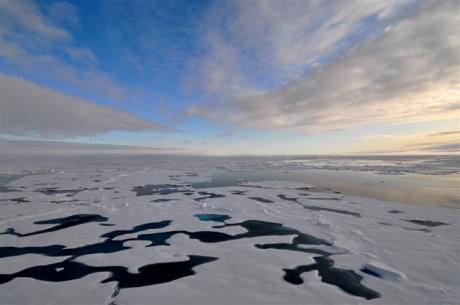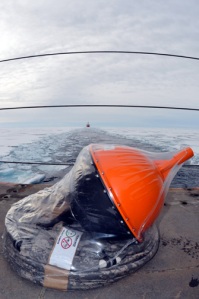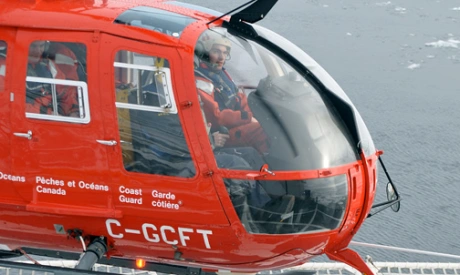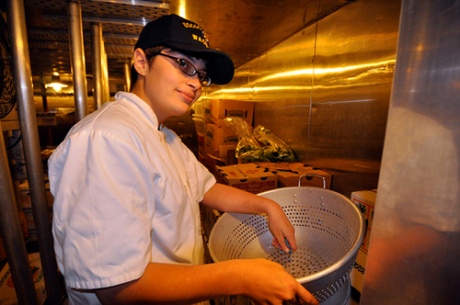On this Healy trip we have several different people emailing blog entries back ashore to people who are posting them. In fact there is so much blog traffic being generated on Healy that I thought it would be a good idea for us to work together to generate the most possible exposure for each of the ongoing Healy blogs as possible. Thus, I coined the term “cross-blogination.” Basically, we have decided to share material so that we can shed a little light on each other while we are also providing new and interesting material to our own unique audience.
So without further delay, here is the first of the hopefully many products of cross-blogination. It was originally posted to www.continentalshelf.gov and USGS.gov.
The Otherworldly Sights and Sounds of the Arctic

August 23, 2009 · Filed Under 2009, Journey
Petty Officer Patrick Kelley, U.S. Coast Guard
I am a photographer, videographer and journalist in the U.S. Coast Guard. During this mission, I am onboard Healy to document this historic voyage to map the ocean floor and define the outer reaches of our continental shelf.
If you are reading this, you most likely have an infinitely greater understanding of the complexities of what the science team is doing to accomplish its goals than I do. You probably know better than I what the significance of 12khz multi-beam sonar is to the oceanographers. You probably know why pockmarks on the Chukchi Cap are relevant to the geologists.
 What you might not have, however, is an idea of what we aboard Healy are seeing and experiencing. This region is amazingly unique, awesome, and striking. So instead of offering a feeble attempt to explain the very complicated scientific research underway, I am simply providing you a description of our temporary environment.
What you might not have, however, is an idea of what we aboard Healy are seeing and experiencing. This region is amazingly unique, awesome, and striking. So instead of offering a feeble attempt to explain the very complicated scientific research underway, I am simply providing you a description of our temporary environment.
We are a little more than two weeks into our journey into the Arctic Ocean, and I am still amazed by what I see each day. We have seen four polar bears, a few rare birds and many seals. However, the most incredible feature of the Arctic, in my opinion, is the ice itself.
As we move through the Arctic Ocean, the ice changes from one location to the next. The change is not just the thickness, as I had anticipated, but also the color, density, and texture. In some areas, the ice looks harsh and unwilling to yield to the weight of Healy, and in other spots it appears that the ice attempts to flee before the ship gets to it. Sometimes when you look out you feel like you are cruising through a snow-covered prairie. The next day, it’s as though you have landed on a rocky, frozen planet and the ship has to blast its way through.
 When it comes to color, you might think only of blue and white as the prevailing colors of the extreme north. While those are the most common colors, just calling them blue and white is not sufficient. I have seen more shades of blue here than any home improvement store paint department could hope to produce, and until I got here, I didn’t even realize there was more than one shade of white. The frozen pools that form on top of the multi-year ice floes create the most astonishing shade of blue I have ever seen. The white ice background creates an intense contrast, which makes the blue stand out even more.
When it comes to color, you might think only of blue and white as the prevailing colors of the extreme north. While those are the most common colors, just calling them blue and white is not sufficient. I have seen more shades of blue here than any home improvement store paint department could hope to produce, and until I got here, I didn’t even realize there was more than one shade of white. The frozen pools that form on top of the multi-year ice floes create the most astonishing shade of blue I have ever seen. The white ice background creates an intense contrast, which makes the blue stand out even more.
When the fog clears enough for the sun to make an appearance, gold becomes an important player in the color scheme of the Arctic. When the sun is out, the ocean water appears to be a deep shade of black. When we are not completely surrounded by ice, the sun reflects off the black water and the bright white of the ice and creates a brilliant golden haze that runs along the horizon. And at this time of the year, the sun does not drop below the horizon; instead, you have a lasting sunset or sunrise.
 If you are out on deck while the ship is breaking ice, you can actually hear the ice strain under the weight of the hull and snap when the load is too much for the sheet to bear. From inside the ship, you hear a deep rumble when Healy confronts large sheets of ice. The sound of the ship colliding with a smaller chunk of ice is more of a loud bang.
If you are out on deck while the ship is breaking ice, you can actually hear the ice strain under the weight of the hull and snap when the load is too much for the sheet to bear. From inside the ship, you hear a deep rumble when Healy confronts large sheets of ice. The sound of the ship colliding with a smaller chunk of ice is more of a loud bang.
Having spent the majority of my career on boats and cutters, I am still struggling to wrap my mind around the fact that one of Healy’s primary purposes is to go out to sea and run into a major navigational hazard, over and over again. I guess at some point I won’t flinch when the ship rocks, rolls, and shakes through an eight-foot-thick sheet of ice.
This for me is a once in a lifetime trip that I hope to someday tell my grandkids about. If you are ever offered the opportunity to make your way to the top of the world, do not pass it up. I would hate for you to miss out because no one ever told you how amazing the Arctic Ocean is.

August 27, 2009
Categories: Uncategorized . Tags: arctic, breaker, Canadian, Coast, Cutter, Guard, Healy, ice, Louis, ocean, Polar, S. St-Laurent, science . Author: cutterhealy . Comments: Leave a comment


 What you might not have, however, is an idea of what we aboard Healy are seeing and experiencing. This region is amazingly unique, awesome, and striking. So instead of offering a feeble attempt to explain the very complicated scientific research underway, I am simply providing you a description of our temporary environment.
What you might not have, however, is an idea of what we aboard Healy are seeing and experiencing. This region is amazingly unique, awesome, and striking. So instead of offering a feeble attempt to explain the very complicated scientific research underway, I am simply providing you a description of our temporary environment. When it comes to color, you might think only of blue and white as the prevailing colors of the extreme north. While those are the most common colors, just calling them blue and white is not sufficient. I have seen more shades of blue here than any home improvement store paint department could hope to produce, and until I got here, I didn’t even realize there was more than one shade of white. The frozen pools that form on top of the multi-year ice floes create the most astonishing shade of blue I have ever seen. The white ice background creates an intense contrast, which makes the blue stand out even more.
When it comes to color, you might think only of blue and white as the prevailing colors of the extreme north. While those are the most common colors, just calling them blue and white is not sufficient. I have seen more shades of blue here than any home improvement store paint department could hope to produce, and until I got here, I didn’t even realize there was more than one shade of white. The frozen pools that form on top of the multi-year ice floes create the most astonishing shade of blue I have ever seen. The white ice background creates an intense contrast, which makes the blue stand out even more. If you are out on deck while the ship is breaking ice, you can actually hear the ice strain under the weight of the hull and snap when the load is too much for the sheet to bear. From inside the ship, you hear a deep rumble when Healy confronts large sheets of ice. The sound of the ship colliding with a smaller chunk of ice is more of a loud bang.
If you are out on deck while the ship is breaking ice, you can actually hear the ice strain under the weight of the hull and snap when the load is too much for the sheet to bear. From inside the ship, you hear a deep rumble when Healy confronts large sheets of ice. The sound of the ship colliding with a smaller chunk of ice is more of a loud bang.
 ARCTIC OCEAN – Below you will find an article created by D-17 Public Affairs. The article includes a few quotes from the chief scientist at the National Ice Center, Pablo Clemente Colón, who just happens to be underway onboard the Healy right now. So we figured it would be a good idea to put the article on the Healy blog as well:
ARCTIC OCEAN – Below you will find an article created by D-17 Public Affairs. The article includes a few quotes from the chief scientist at the National Ice Center, Pablo Clemente Colón, who just happens to be underway onboard the Healy right now. So we figured it would be a good idea to put the article on the Healy blog as well: “We are leaning forward to gain a thorough understanding of the cultural, environmental and operational challenges the Coast Guard faces in Northern Alaska and the Arctic domain. As such, we need to project a persistent presence in these remote regions to expand our knowledge of the environment and protect U.S. sovereignty,” said Capt. Robert Phillips, Chief, Incident Management Branch Seventeenth Coast Guard District. “In order to accomplish these goals we are partnering with the scientific community and other federal agencies, such as NOAA, to join us in collecting data for future operations and a successful road ahead in the Arctic.”
“We are leaning forward to gain a thorough understanding of the cultural, environmental and operational challenges the Coast Guard faces in Northern Alaska and the Arctic domain. As such, we need to project a persistent presence in these remote regions to expand our knowledge of the environment and protect U.S. sovereignty,” said Capt. Robert Phillips, Chief, Incident Management Branch Seventeenth Coast Guard District. “In order to accomplish these goals we are partnering with the scientific community and other federal agencies, such as NOAA, to join us in collecting data for future operations and a successful road ahead in the Arctic.” “This effort signals the beginning of airborne deployments by Coast Guard C-130 Hercules Arctic Domain Awareness flights in support of the buoy network,” said Pablo Clemente-Colón, chief scientist of the National Ice Center and an oceanographer with NOAA who is currently deployed aboard the Coast Guard Cutter Healy.
“This effort signals the beginning of airborne deployments by Coast Guard C-130 Hercules Arctic Domain Awareness flights in support of the buoy network,” said Pablo Clemente-Colón, chief scientist of the National Ice Center and an oceanographer with NOAA who is currently deployed aboard the Coast Guard Cutter Healy. The ice drifting buoy uses a modified version of the World Ocean Circulation Experiment (WOCE) buoy. These WOCE buoys are drogued at 50 or 150 feet to track the deep water currents that affect iceberg drift. The drifters also measure the sea surface temperature using a thermister on the underside of the surface float.
The ice drifting buoy uses a modified version of the World Ocean Circulation Experiment (WOCE) buoy. These WOCE buoys are drogued at 50 or 150 feet to track the deep water currents that affect iceberg drift. The drifters also measure the sea surface temperature using a thermister on the underside of the surface float. The buoy’s locations and data can be seen at the
The buoy’s locations and data can be seen at the  Further information regarding the Coast Guard’s North Slope operations and Operation Arctic Crossroads can be found at the
Further information regarding the Coast Guard’s North Slope operations and Operation Arctic Crossroads can be found at the 
 ARCTIC OCEAN – Fireman Mike Miozzi (right) returns to the Coast Cutter Healy after spending the day aboard the Canadian Coast Guard Ship Louis S. St-Laurent Aug. 17, 2009.
ARCTIC OCEAN – Fireman Mike Miozzi (right) returns to the Coast Cutter Healy after spending the day aboard the Canadian Coast Guard Ship Louis S. St-Laurent Aug. 17, 2009.
 ARCTIC OCEAN – Seaman Melissa Gomes, a Seattle native, prepares to select fresh vegetables to be served with the evening meal Aug.13, 2009, on the Coast Guard Cutter Healy.
ARCTIC OCEAN – Seaman Melissa Gomes, a Seattle native, prepares to select fresh vegetables to be served with the evening meal Aug.13, 2009, on the Coast Guard Cutter Healy.








